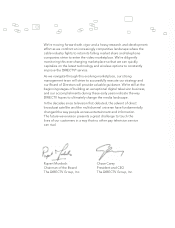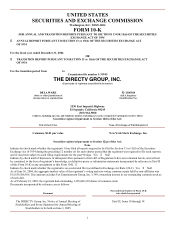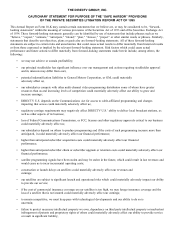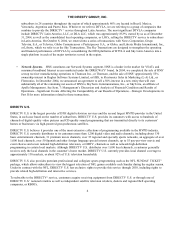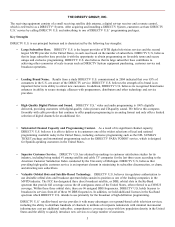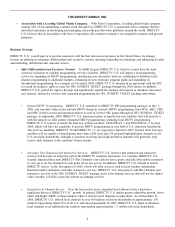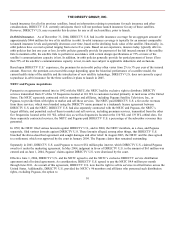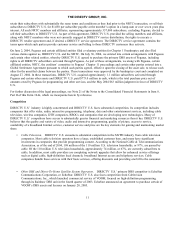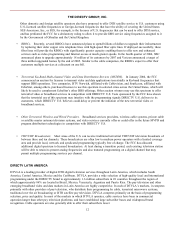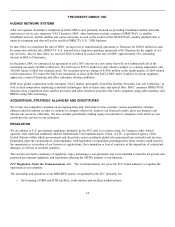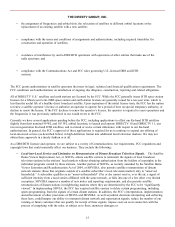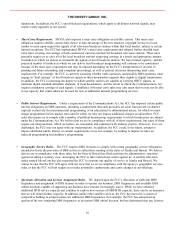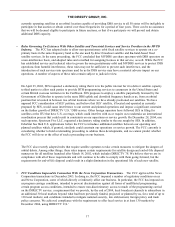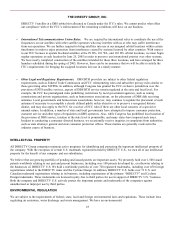DIRECTV 2004 Annual Report Download - page 18
Download and view the complete annual report
Please find page 18 of the 2004 DIRECTV annual report below. You can navigate through the pages in the report by either clicking on the pages listed below, or by using the keyword search tool below to find specific information within the annual report.
THE DIRECTV GROUP, INC.
programming instead of broadband data services, as originally planned. DIRECTV U.S. also plans to launch DIRECTV 10 and
DIRECTV 11 in 2007. These four satellites will provide DIRECTV U.S. with increased capability for local and national high-
definition channels, as well as capacity for new interactive and enhanced services and standard-definition programming. Once
launched, these satellites will operate from our Ka-band orbital locations. In addition, DIRECTV 12S is also being built and
will serve as a ground spare.
Digital Broadcast Centers. To gather programming content, ensure its digital quality, and transmit that content to its satellites,
DIRECTV U.S. built two digital broadcast centers, located in Castle Rock, Colorado and Los Angeles, California. Almost all of
the functions necessary to provide satellite-delivered services occur at these digital broadcast centers. Programming comes to
the broadcast centers from DIRECTV U.S.’ content providers via satellite, fiber optic cable and/or special tape. Most satellite-
delivered programming is then immediately digitized, encoded and uplinked to DIRECTV U.S.’ satellites. Each broadcast
center was designed with redundant systems to minimize service interruptions from that location due to unforeseen
circumstances.
Installation Network. DIRECTV U.S.’ DIRECTV HOME SERVICES® installation and service network performs service call
work and approximately 40% of all new professional customer installations through 14 outsourced companies with over 12,000
technicians around the United States. For these outsourced companies, DIRECTV U.S. sets the installation and service
standards, performs quality control, manages inventory and monitors the overall service network performance. In addition,
DIRECTV U.S. and its retailers also utilize employer-based or contract installation providers, which perform the remainder of
all new professional customer installations.
Customer Service Centers. DIRECTV U.S. currently uses 17 customer service centers employing approximately 12,000
customer service representatives. Fourteen of these customer service centers, employing approximately 9,000 customer service
representatives, are operated by Convergys Customer Management Group, Inc., Precision Response Corporation and
ClientLogic Operating Corporation. DIRECTV U.S. owns three customer service centers located in Boise, Idaho, Tulsa,
Oklahoma and Huntsville, Alabama that employ approximately 3,000 customer service representatives. Potential and existing
subscribers can call a single telephone number 24 hours a day, seven days a week, to request assistance for hardware,
programming, installation and technical support. DIRECTV U.S. continues to increase the functionality of telephone-based and
web-based self-care features in order to better manage customer service costs and improve service levels.
Satellite Insurance
DIRECTV U.S. uses launch and in-orbit insurance to mitigate the potential financial impact of satellite fleet launch and in-orbit
failures unless the premium costs are considered to be uneconomical relative to the risk of satellite failure. DIRECTV U.S. does
not insure against lost revenues in the event of a total or partial loss of the capacity of a satellite.
Launch Insurance. Launch insurance typically covers the time frame from intentional ignition of the launch vehicle through
separation of the satellite from the launch vehicle. For example, if the satellite is lost during launch or the satellite fails to
achieve the proper orbital location, DIRECTV U.S. would expect to receive payment for the full insured amount. If the satellite
experiences a partial loss of its communications capacity as a result of a launch vehicle malfunction, DIRECTV U.S. would
expect to receive the payment for a portion of the insured amount.
The premium on a launch insurance policy can vary considerably based on the past historical performance of the launch vehicle
and other market conditions. Based upon DIRECTV U.S.’ experience, premiums in the industry generally range from 15% to
30% of the insured amount for a policy covering the launch and one year of in-orbit coverage thereafter. Payment for launch
insurance policies is made prior to launch.
DIRECTV U.S. has been evaluating whether to purchase launch insurance for the three satellites it expects to launch in 2005
(SPACEWAY 1, SPACEWAY 2 and DIRECTV 8). Although DIRECTV U.S. has purchased
9


